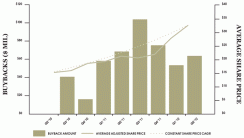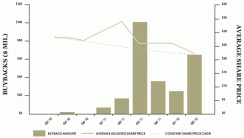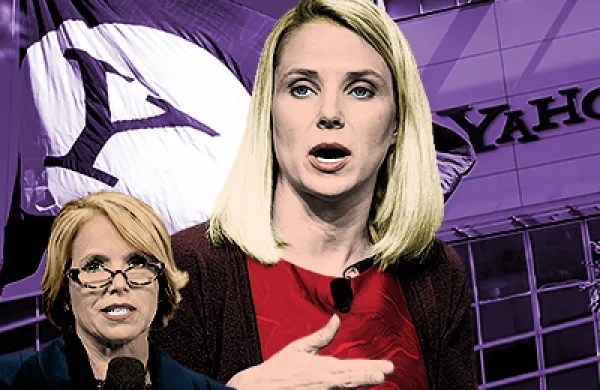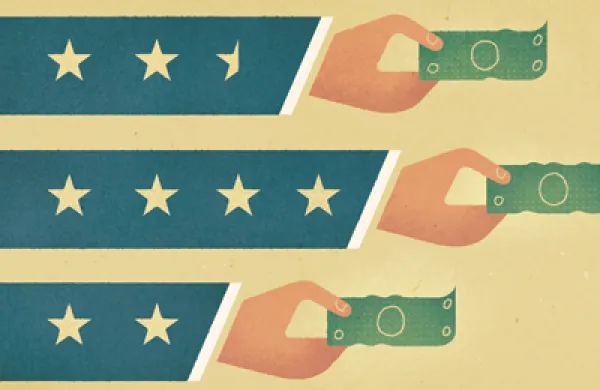| Buyback Scorecard The Most and Least Effective Stock Buyback ProgramsThe S&P 500 as Stock RepurchasersBest and Worst ProgramsIndustry Comparisons |
But Wyndham’s payback appears to validate the repurchases. The company’s 63.1 percent buyback ROI was three times the consumer services median. Accounting for that was a buyback strategy that produced a return that was double the median in its sector and that dwarfed the 9.6 percent median for all companies, and effectiveness that produced a robust 12.6 percent return versus a negative 0.4 percent in its sector and a more dramatically worse negative 2.2 percent median overall.
| Fortuna Advisors Buyback ROIWyndham Worldwide Corporation (NYSE:WYN) | ||

| ||
| Buyback ROI | 63.1% | Annualized IRR based on $ of buybacks, avoided dividends and value of shares at ending share price |
| Buyback Strategy | 44.8% | Annualized TSR of quarterly average starting price, dividends and ending price. Buybacks lever up TSR when it is high. |
| Buyback Effectiveness | 12.6% | Shows degree to which Buyback ROI exceeds TSR. Buying shares back when the price is below the long term trend is beneficial. |
| Note: Estimated number of shares repurchased each quarter based on average adjusted share price over the course of the quarter. | ||
In contrast, FLIR Systems, which designs, manufactures and markets thermal imaging infrared cameras, produced a buyback ROI over the past two years that at No. 240, placed it 14th from the bottom of the S&P 500 and 16th out of 18 in the Technology Hardware and Equipment Industry, ahead of only Hewlett-Packard and Juniper Networks, with a negative 27 percent ROI on $253 million in buybacks. Not surprisingly, its buyback strategy produced a negative 12.8 percent return, while its buyback effectiveness lost 16.6 percent.
In the company’s defense, FLIR vice president of finance Tony Trunzo says the Fortuna study focuses too much on the short term. Over nine years, Trunzo estimates that FLIR buybacks have created significant value for shareholders. He notes that the average price paid to repurchase FLIR shares since 2003 is $16.28, versus an average stock price of $21.50, and that includes a 40 percent slide from the peak stock price. As a result, Trunzo says the program has generated “a slightly positive” internal rate of return. And he estimates that the program saved shareholders around $300 million, based on the difference in prices paid for the shares versus the average price for the period.
On a relative basis, however, FLIR’s buyback ROI over the longer period was only so-so, says Greg Milano, CEO of Fortuna Advisors of New York City. He notes that an asset that rises in value by a third over nine years amounts to a 3 percent annual return — below the level of returns on investment that shareholders ordinarily expect. Still, Trunzo has a point, says fund manager Tom Kolefas at TIAA–CREF. Two years may not capture a complete economic cycle over which disciplined buyback strategies tend to deliver higher returns, he notes. But Kolefas points out that the buyback analysis puts FLIR on a level playing field with hundreds of companies subject to identical market conditions since June 2010, and is useful for that reason alone.
| Fortuna Advisors Buyback ROIFLIR Systems, Inc. (NasdaqGS:FLIR) | ||

| ||
| Buyback ROI | -27.3% | Annualized IRR based on $ of buybacks, avoided dividends and value of shares at ending share price |
| Buyback Strategy | -12.8% | Annualized TSR of quarterly average starting price, dividends and ending price. Buybacks lever up TSR when it is high. |
| Buyback Effectiveness | -16.6% | Shows degree to which Buyback ROI exceeds TSR. Buying shares back when the price is below the long term trend is beneficial. |
| Note: Estimated number of shares repurchased each quarter based on average adjusted share price over the course of the quarter. | ||





